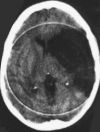Crossmodal visual-tactile extinction: Modulation by posture implicates biased competition in proprioceptively reconstructed space
- PMID: 19822034
- PMCID: PMC3229705
- DOI: 10.1348/174866409X415942
Crossmodal visual-tactile extinction: Modulation by posture implicates biased competition in proprioceptively reconstructed space
Abstract
Extinction is a common consequence of unilateral brain injury: contralesional events can be perceived in isolation, yet are missed when presented concurrently with competing events on the ipsilesional side. This can arise crossmodally, where a contralateral touch is extinguished by an ipsilateral visual event. Recent studies showed that repositioning the hands in visible space, or making visual events more distant, can modulate such crossmodal extinction. Here, in a detailed single-case study, we implemented a novel spatial manipulation when assessing crossmodal extinction. This was designed not only to hold somatosensory inputs and hand/arm-posture constant, but also to hold (retinotopic) visual inputs constant, yet while still changing the spatial relationship of tactile and visual events in the external world. Our right hemisphere patient extinguished left-hand touches due to visual stimulation of the right visual field (RVF) when tested in the usual default posture with eyes/head directed straight ahead. But when her eyes/head were turned to the far left (and any visual events shifted along with this), such that the identical RVF retinal stimulation now fell at the same external location as the left-hand touch, crossmodal extinction was eliminated. Since only proprioceptive postural cues could signal this changed spatial relationship for the critical condition, our results show for the first time that such postural cues alone are sufficient to modulate crossmodal extinction. Identical somatosensory and retinal inputs can lead to severe crossmodal extinction, or none, depending on current posture.
Figures




Similar articles
-
Neural correlates of crossmodal visual-tactile extinction and of tactile awareness revealed by fMRI in a right-hemisphere stroke patient.Neuropsychologia. 2006;44(12):2398-410. doi: 10.1016/j.neuropsychologia.2006.04.032. Neuropsychologia. 2006. PMID: 16765998
-
Left tactile extinction following visual stimulation of a rubber hand.Brain. 2000 Nov;123 ( Pt 11):2350-60. doi: 10.1093/brain/123.11.2350. Brain. 2000. PMID: 11050034
-
Attentional competition between modalities: extinction between touch and vision after right hemisphere damage.Neuropsychologia. 1997 Jun;35(6):867-80. doi: 10.1016/s0028-3932(97)00008-0. Neuropsychologia. 1997. PMID: 9204491
-
The representation of space near the body through touch and vision.Neuropsychologia. 2010 Feb;48(3):782-95. doi: 10.1016/j.neuropsychologia.2009.10.010. Epub 2009 Oct 26. Neuropsychologia. 2010. PMID: 19837101 Review.
-
Suppression of extinction with TMS in humans: from healthy controls to patients.Behav Neurol. 2006;17(3-4):163-7. doi: 10.1155/2006/393924. Behav Neurol. 2006. PMID: 17148836 Free PMC article. Review.
Cited by
-
The Embodiment of Objects: Review, Analysis, and Future Directions.Front Neurosci. 2019 Dec 13;13:1332. doi: 10.3389/fnins.2019.01332. eCollection 2019. Front Neurosci. 2019. PMID: 31920499 Free PMC article. Review.
-
Within-hemifield posture changes affect tactile-visual exogenous spatial cueing without spatial precision, especially in the dark.Atten Percept Psychophys. 2014 May;76(4):1121-35. doi: 10.3758/s13414-013-0484-3. Atten Percept Psychophys. 2014. PMID: 24470256 Free PMC article. Clinical Trial.
-
Hemispheric asymmetry: Looking for a novel signature of the modulation of spatial attention in multisensory processing.Psychon Bull Rev. 2017 Jun;24(3):690-707. doi: 10.3758/s13423-016-1154-y. Psychon Bull Rev. 2017. PMID: 27586002 Free PMC article. Review.
References
-
- Aglioti S, Smania N, Moro V, Peru A. Tactile salience influences extinction. Neurology. 1998;50:1010–1014. - PubMed
-
- Battersby WS, Bender MB, Pollack M, Kahn RL. Unilateral spatial agnosia (inattention) in patients with cerebral lesions. Brain. 1956;79:68–93. - PubMed
-
- Becker E, Karnath HO. Incidence of visual extinction after left versus right hemisphere stroke. Stroke. 2007;38:3172–3174. - PubMed
-
- Bellas DN, Novelly RA, Eskenazi B. Olfactory lateralization and identification in right-hemisphere lesion and control patients. Neuropsychologia. 1989;27:1187–1191. - PubMed
-
- Bender MB. Disorders in perception. Springfield, IL: Charles C. Thomas; 1952.
Publication types
MeSH terms
Grants and funding
LinkOut - more resources
Full Text Sources
Medical

